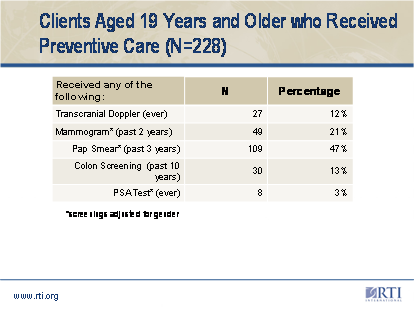Sickle Cell Disease Programs
The MCHB Sickle Cell Disease programs serve individuals across the life span affected by and living with sickle cell disease or who are carriers of the sickle cell gene mutation. The programs have established coordinated, comprehensive and family-centered networks to promote the integration of primary and subspecialty health care within medical homes for persons with sickle cell diseases and other hemoglobinopathies. The networks enhance clinical and social support follow-up services as well as support their families. Program activities also focus on health promotion, education and training and the improvement of treatment of sickle cell disease throughout an individual’s life course.
Activities
The Sickle Cell Disease Treatment and Demonstration Program was established in 2004 to improve access to services for individuals with sickle cell disease, improve and expand patient and provider education, improve and expand the continuity and coordination of service delivery for individuals with sickle cell disease or who are carriers of the sickle cell gene mutation. Grantee networks have two main goals, first to support the provision of coordinated, comprehensive, culturally competent and family-centered care for individuals living with sickle cell disease and second, to work collaboratively with partners such as Federally Qualified Health Centers; nonprofit hospitals or clinics; university health centers offering primary care; subspecialty comprehensive sickle cell centers; and community-based organizations that provide resources to people living with sickle cell disease.
A national coordinating center was created to coordinate and support grantee networks through technical assistance and information exchange; build and sustain partnerships; centralize data collection and analysis; review and develop educational materials; identify performance measures and quality indicators; and identify best practices relative to prevention and treatment of Sickle Cell Disease.
The Coordinating Center is led by the National Initiative for Children’s Healthcare Quality. One of the focal points of the technical assistance is through the development of hemoglobinopathy learning collaborative so that the network teams may learn from each other and from national expert faculty to make meaningful improvements in caring for individuals living with sickle cell disease.
The Sickle Cell Disease for Newborn Screening Program was established in 2002 to utilize a regional approach to support community-based systems of care. Program grantees establish a network of community partners to provide a seamless system for the early detection and proper treatment of hemoglobinopathies. These partners represent providers of both the clinical and social services needs of individuals living with sickle cell disease. Community-based networks partner with State Title V and state newborn screening programs, comprehensive sickle cell treatment centers, and health care professionals, national service organizations, allied health practitioners organizations and specialists to provide support to individuals across the life course who have screened positive for sickle cell disease and/or carriers of the sickle cell gene mutation, and their families.
The projects work cooperatively with their National Coordinating and Evaluation Center to implement a model program of follow-up for individuals with sickle cell diseases or who may carry the genetic mutation for the disorder to include notification of results of newborn screening, extended family testing, counseling and education of identified individuals and their families, and enrollment of affected individuals into a medical home.
Highlights
The Sickle Cell Disease programs have an active evaluation component to assess improvements in the quality of activities including screening, counseling, education of identified individuals, their families and healthcare providers, and enrollment of individuals into a medical home for comprehensive care, utilization of emergency rooms and length of hospital stays.
In addition outreach and education activities are provided to emerging populations such as ethnically, multi-racial or literacy diverse populations. Both programs are responsible for assessing gaps in educational materials. The Sickle Cell Disease Newborn Screening Program has developed the Sickle Cell Disease Welcome Kit. This tool provides families health information for the care of their child (0-5 years) diagnosed with sickle cell disease. With the kit, a family can keep track of appointments and make notes of information during visits with health care providers. The Sickle Cell Disease Welcome Kit also provides educational information on when it is necessary to call a doctor or seek emergency care for their child. The information sheets incorporated in the Welcome Kit can be found on the coordinating center website, www.sicklecelldisease.net 
Resources
Sickle Cell Disease Association of America www.sicklecelldisease.org 
National Coordinating and Evaluation Center www.sicklecelldisease.net 
National Initiative for Children’s Healthcare Quality www.nichq.org 
Data from Sickle Cell Disease Treatment Demonstration Program - Cohort 1 (2006-2010)






